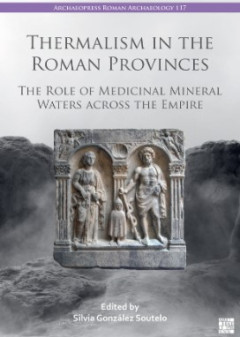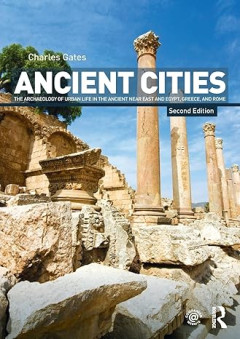Ditapis dengan
E-book Gematon: Living and Dying in a Kushite Town on the Nile : The Pottery
The pottery published in this volume was excavated and recorded between 1997 and 2018. During the first seasons only diagnostic sherds (rims, bases, handles, decorated pottery and unusual fabrics) were recorded, ignoring the non-diagnostic body sherds for the sake of keeping up with the quantity of pottery excavated. This concerns only the pottery from Area B and part of…
- Edisi
- vol. III
- ISBN/ISSN
- 9781803276793
- Deskripsi Fisik
- 415 hlm
- Judul Seri
- -
- No. Panggil
- 930.1 SJO g

E-book Thermalism in the Roman Provinces: The Role of Medicinal Mineral Water…
Thermal establishments with mineral-medicinal waters represent a special case among Roman bath buildings, not only because of the adaptation of the space to the use of these waters for health issues, but also because of the infrastructures and engineering they developed, as well as for their function in the landscape. Thermalism in the Roman Provinces is focused on the role of thermal esta…
- Edisi
- -
- ISBN/ISSN
- 9781803277769
- Deskripsi Fisik
- 230 halaman, ilus.
- Judul Seri
- -
- No. Panggil
- 930.1 SOU t
E-book Unter Hügeln
Der Begriff ‚Transformation‘ stammt vom lateinischen Wort ‚transformare‘ ab und bedeutet, dass etwas umgewandelt, umgeformt oder umgestaltet wird (Brockhaus Enzyklopädie 2006, 311). Dabei kann es sich sowohl um einen Gegenstand in der Natur-, als auch in der Geisteswissenschaft handeln, der sich transformiert bzw. transformiert wird. Die Folgen einer Transformation sind Verän…
- Edisi
- -
- ISBN/ISSN
- 9789464280500
- Deskripsi Fisik
- 542 hlm
- Judul Seri
- -
- No. Panggil
- 930.1 SCH u
E-book Tales of Two Cities: Settlement and Suburb in Old Sarum and Salisbury
Telling the story of Old Sarum and Salisbury, from the mid-10th century to the start of the 20th, this book brings together the most up-to-date thinking on the archaeological evidence, and, through analysis of the rich documentary record, provides a fresh take on the story of this most illustrious cathedral city in the heart of southern England. Tales of Two Cities tells the story of Old Sar…
- Edisi
- -
- ISBN/ISSN
- 9781803277608
- Deskripsi Fisik
- 360 halaman, ilus.
- Judul Seri
- -
- No. Panggil
- 930.1 COO t
E-book A Greek State in Formation : The Origins of Mycenaean Pylos
The Bronze Age in Greece began around 3100 B.C. with the first bronze work-ing for the manufacture of tools and weapons (see map 1). Already in the Neo-lithic, there had been limited use of copper, the essential ingredient of bronze, while stone tools were still essential for some purposes in the Bronze Age. Copper typically was alloyed with tin to produce bronze, but…
- Edisi
- -
- ISBN/ISSN
- 9780520387256
- Deskripsi Fisik
- 2022
- Judul Seri
- -
- No. Panggil
- 930.1495 DAV a

E-book Ancient Cities: The Archaeology of Urban Life in The Ancient Near East…
Ancient Cities surveys the cities of the Ancient Near East, Egypt, and the Greek and Roman worlds from the perspectives of archaeology and architectural history, bringing to life the physical world of ancient city dwellers by concentrating on evidence recovered from archaeological excavations. Urban form is the focus: the physical appearance and overall plans of the cities, their architecture a…
- Edisi
- -
- ISBN/ISSN
- 9780203830574
- Deskripsi Fisik
- 503 halaman, ilus.
- Judul Seri
- -
- No. Panggil
- 930.1 GAT a
E-book Current Research in Egyptology 2023: Proceedings of the Twenty-Third A…
Collecting 22 selected papers from the twenty-third Current Research in Egyptology conference, topics include language and literature, archaeology and material culture, society and religion, archival research, intercultural relations, reports on archaeological excavations and methodological issues, regarding all periods of Ancient Egypt. The twenty-third Current Research in Egyptology confer…
- Edisi
- -
- ISBN/ISSN
- 9781803278223
- Deskripsi Fisik
- 382 halaman, ilus.
- Judul Seri
- -
- No. Panggil
- 930.1 UNI c
E-book In Pursuit of Visibility: Essays in Archaeology, Ethnography, and Text…
In Pursuit of Visibility honors the distinguished career of a scholar of Canaan and ancient Israel, Beth Alpert Nakhai. In fifteen diverse essays, Professor Nakhai’s students and colleagues celebrate her important contributions to the field of Near Eastern Archaeology, including her research into gender, household, and cult in the Bronze and Iron Age southern Levant, and her tireless efforts …
- Edisi
- -
- ISBN/ISSN
- 9781803272320
- Deskripsi Fisik
- 212 halaman, ilus.
- Judul Seri
- -
- No. Panggil
- 930.1 EBE i
E-book How to Read Ancient Texts: With a Focus on Select Phoenician Inscripti…
How to Read Ancient Texts foregrounds the principles of interpretation that scholars employ when reading ancient inscriptions. In order to better come to grips with Canaanite, such as Phoenician, inscriptions, we need to first understand how people wrote and read texts in the ancient Mediterranean world, including that of the Greeks and Romans. The use of continual script and lack of punctuatio…
- Edisi
- -
- ISBN/ISSN
- -
- Deskripsi Fisik
- 140 halaman
- Judul Seri
- -
- No. Panggil
- 930.1 FRE h
E-book The Prehistoric Maritime Frontier of Southeast China : Indigenous Bai …
This book presents multidisciplinary research on the cultural history, ethnic con-nectivity, and oceanic transportation of the ancient indigenousBai Yue(??) in themaritime region of southeast China and Southeast Asia. It is compiled with anumber of different theses which have been successively published in Chinesejournals in the last 20 years focusing on the indigenousBai Yueculture duringpreh…
- Edisi
- -
- ISBN/ISSN
- 9789811640797
- Deskripsi Fisik
- 275 hlm
- Judul Seri
- -
- No. Panggil
- 930.1 CHU t
 Karya Umum
Karya Umum  Filsafat
Filsafat  Agama
Agama  Ilmu-ilmu Sosial
Ilmu-ilmu Sosial  Bahasa
Bahasa  Ilmu-ilmu Murni
Ilmu-ilmu Murni  Ilmu-ilmu Terapan
Ilmu-ilmu Terapan  Kesenian, Hiburan, dan Olahraga
Kesenian, Hiburan, dan Olahraga  Kesusastraan
Kesusastraan  Geografi dan Sejarah
Geografi dan Sejarah